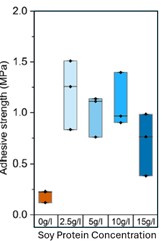Biomineralized Soy-Protein Adhesive for Strong, Sustainable Bonding on Challenging Surfaces
Up to 6-fold strength gains over unreinforced soy adhesives; adheres to glass and stainless steel with minimal surface preparation
Background:
Conventional indoor adhesives—used in flooring, furniture, and general-purpose applications — often pose challenges related to toxicity, environmental impact, and poor performance on non-porous surfaces like glass and stainless steel. These limitations are driving strong demand for safer, more sustainable, and high-performing alternatives. Montana State University bioengineering faculty are addressing this need by developing bio-based adhesive systems designed for improved safety and performance.
Technology Overview:
Montana State University has developed a soy protein–based bioadhesive strengthened through Enzyme-Induced Calcium Precipitation (EICP), a process that embeds microscopic calcium carbonate minerals within the adhesive matrix to significantly enhance bonding strength. This bioadhesive combines a renewable plant-derived protein with an in situ mineral reinforcement, enabling strong adhesion to non-porous surfaces such as glass and stainless steel.
The adhesive integrates renewable soy protein with mineral reinforcement, achieving bonding strength in the range reported for certain non-structural acrylic and rubber adhesives. The process uses a purified urease enzyme, enabling fast, clean, and controllable processing—making it suitable for scalable industrial manufacturing.

Figure 1: Adhesive strength of biobased adhesive as a function of soy protein concentration, measured on glass substrates using 0.33 M CaCl₂ and urease enzyme. Box plots show increasing strength with protein concentration, peaking at ~1.5 MPa.
Key Advantages:
- Bio-based: Uses soy protein and enzyme from microbial or plant sources
- Non-toxic & low-VOC: Free of formaldehyde and hazardous solvents
- High shear strength: Up to 1.5 MPa on glass and 2.0 MPa on stainless steel
- Commercially comparable: Matches performance of many indoor adhesives
- Mechanistic validation: Electrostatic bonding and mineral entrapment
- Customizable: Tune viscosity, setting time, and strength as needed
Example Applications:
- Eco-friendly packaging
- Interior construction
- Paper laminates
- Sustainable woodworking
- DIY and hobby glues
Development Stage:
- Lab-validated
- Peer-reviewed publication in Scientific Reports (2025)
Opportunity:
- Available for exclusive or non-exclusive license
- Seeking development or co-innovation partners
Contact:
Nick Zelver
406‐994‐7706
nzelver@montana.edu
